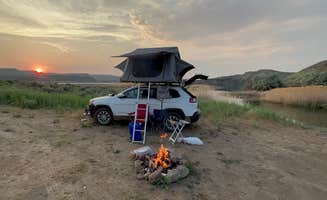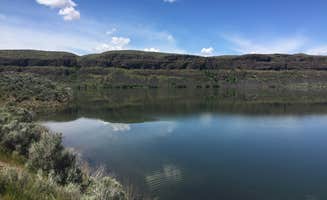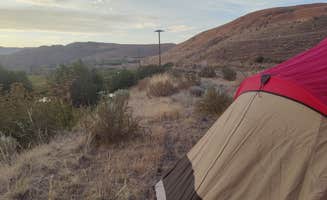Rustic camping near Coulee Dam, Washington centers around public lands in a semi-arid region characterized by sagebrush steppe ecosystem and fluctuating temperatures. The area experiences hot, dry summers with temperatures regularly exceeding 90°F and cool nights even during peak season. Most dispersed sites sit at elevations between 1,200-1,800 feet, offering minimal natural shade with terrain consisting primarily of rocky or sandy soil conditions.
What to do
Paddling and boating opportunities: At Trail Lake Dispersed, visitors can enjoy kayaking in relatively calm waters. One camper noted, "Amazing time and the hosts of the resort are great. I can't wait to come back next year!" while another mentioned it's "great for swimming fishing kayaking paddle boarding."
Stargazing sessions: The limited light pollution creates excellent astronomical viewing conditions. At Jameson Lake, one visitor observed it provides a "Very beautiful night, great for star gazing," making it ideal for astrophotography or constellation spotting during clear nights.
Trout fishing: The lakes in this region are known for productive fishing. According to a camper at Jameson Lake, expect "Lots of trout, caught limit every time. Witnessed someone pull a 18" trout last visit," particularly during spring season before water temperatures rise.
What campers like
Secluded waterfront spots: Many dispersed sites offer direct water access. One camper at Trail Lake Dispersed enjoyed that "We stayed on a side access trail right before this pin drop and it was just as nice, if not better. A few other campers spread out around the lake but very separated from each other."
Fall season colors: The autumn landscape provides scenic camping. A visitor to Jameson Lake reported, "The views of the lake were beautiful especially in the fall," when temperatures moderate and crowds thin after peak summer season.
Minimal development: The basic nature of these sites appeals to those seeking primitive experiences. One camper at Secret Camping Spot #1 appreciated its simplicity, describing it as providing the "Bare Necessities" and noting it's "A place to sleep. You can set up tent on the elevated ridge you see as you drive in off the pull-off from the hwy."
What you should know
Insect management essential: Bug activity intensifies near water sources. A camper at Trail Lake warned about "So many mosquitos!! Beautiful spot, but literally the most mosquitos I've ever seen," while another noted "There are lots of very friendly bugs that want to say hi. When we first arrived, it was pretty breezy. As soon as it died down the welcoming community came out in full effect."
Tent stake challenges: Rocky soil makes setup difficult in some locations. According to one visitor: "As far as the actual camping, it's kind of a chore to set up tents just because the ground is so rocky. But if you have a good mallet and sharp tent steaks as well as some patients you'll be fine."
Roadway noise considerations: Despite remote feel, some sites experience traffic sounds. A camper at Secret Camping Spot #1 reported it was a "Pretty quiet spot even though 300 yards from highway," suggesting selecting sites farther from main roads when possible.
Tips for camping with families
Environmental hazards awareness: Small cacti present potential issues for children. At Secret Camping Spot #1, a visitor cautioned to "be mindful of the cactuses, these are small but quite sharp," suggesting closed-toe shoes and careful site selection for tent placement.
Temperature regulation planning: Significant day-to-night fluctuations require preparation. A camper noted, "It got pretty cool during the evening, even chilly overnight. So it was pretty comfortable overall," recommending layers for children despite hot daytime conditions.
Local resort alternatives: When wilderness camping proves challenging, developed options exist nearby. One visitor suggested "Jack's Resort is extremely well maintained. It has a little cafe. Immaculate bathrooms and even a few cabins for those who would rather," offering a backup plan if dispersed camping conditions become difficult.
Tips from RVers
Wind protection strategies: Position vehicles to minimize exposure to prevailing winds. A camper at Jameson Lake observed the area "can be windy during season change," recommending parking perpendicular to wind direction and using stabilizers.
Parking surface assessment: Evaluate ground conditions before committing to positions. One RVer reported, "There is a large gravel parking lot suitable for large RVs plus those towing a trailer or boat. We chose to find a more secluded site away from the strong winds," suggesting walking sites first to check for levelness and soil stability.
Accessibility considerations: Road conditions vary seasonally. According to an experienced visitor, "You access this area via long wide well graded gravel road," but recommends calling local ranger stations for current conditions after weather events, particularly during spring thaw or after heavy rains.




